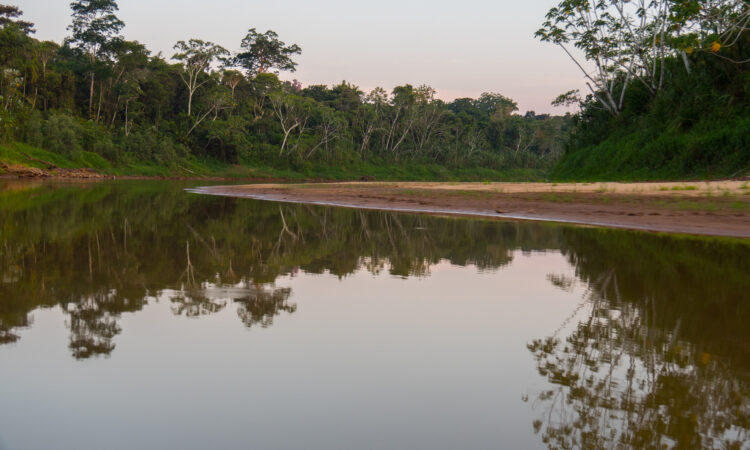But What If We Want Both?
Ah, Gold. So supremely desirable. So very, very valuable. So heavenly to wear, and for the maker of jewelry, so marvelous to work with. Gold has been turning humans’ heads from the beginning of time, and our desire for it based on world-wide demand is only increasing. Yet gold, like other hyper-desirable natural resources, has, as they say, issues.
When I traveled to the Madre de Dios region of Peru in 2015 with my husband Roger, it was for the purpose of experiencing the deep Amazonian rainforest in all its primordial glory. At the river port town of Puerto Maldonado, we went upriver to the East to our destination on the tiny tributary Heath River. Had we instead gone West, we would have encountered sickening scenes from an apocalypse. What we did not know then was that the Madre de Dios Region was then in the grip of a modern day “gold rush” characterized by massive and environmentally devastating informal (illegal) gold mining.
A terrible story was unfolding that would threaten the very existence of the bio-diverse and climate stabilizing paradise that is the Amazonian Rainforest.
Lust for Gold Comes for the Rainforest
Our awareness was raised about problems with diamonds by the movie Blood Diamond in 2006 starring Leonardo Dicaprio. Ten years later, an Amazonian gold rush was in full swing and got its own movie, River of Gold, a documentary narrated by Sissy Spacek and Herbie Hancock. (Available to stream on major platforms.) The film details the multiple horrors of a gold-seeking stampede that brought an estimated 40,000 of illegal miners to rainforest areas in Peru beginning in the early 2000’s, only to accelerate after the global recession in 2008.
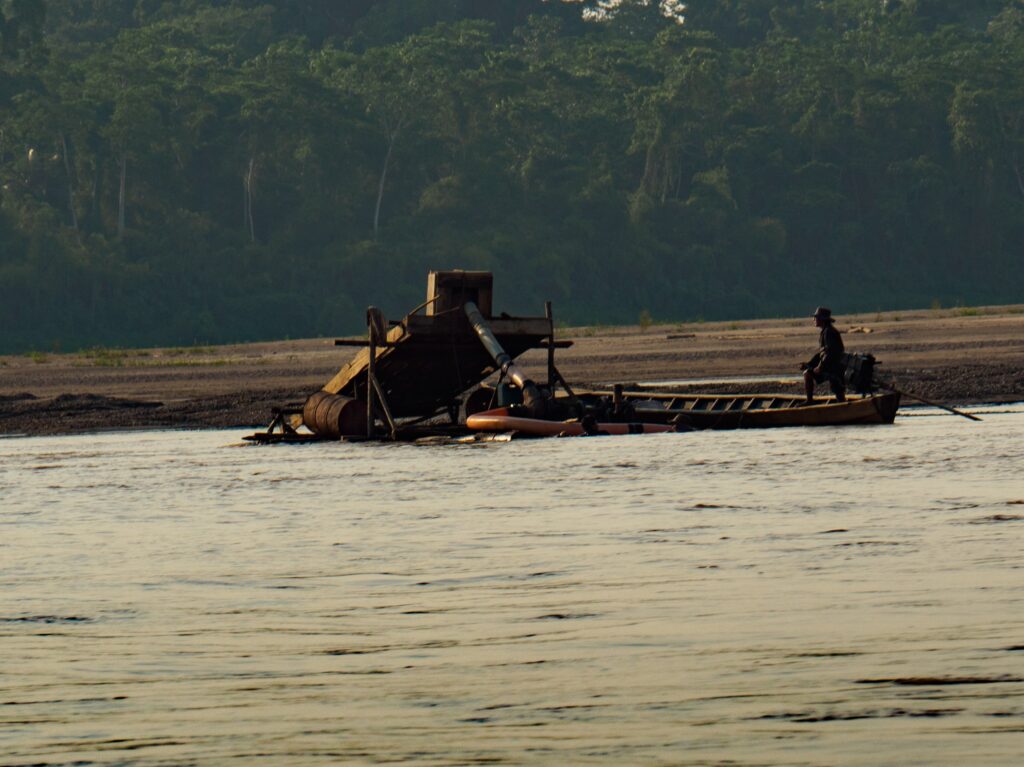
These gold hunters sought their treasure from the river beds and from the forest floor, the ground beneath the Amazonian rainforest itself. In order to mine for gold in the rainforest, the first step is to…cut down all the trees. Hundreds of thousands of acres of rainforest were rapidly chewed up so the earth below could be dug for gold. Next, mix a soil slurry with mercury which easily binds to gold but is toxic. In this process, vast rainforest regions were transformed into uninhabitable mercury-polluted treeless mud flats that can be seen from space. Endangered and protected species were threatened by the loss of habitat.
Since South America’s rainforest plays a major role in the health of the entire planet’s atmosphere and climate, the devastation caused by such rainforest mining became not only a local tragedy but an international disaster.
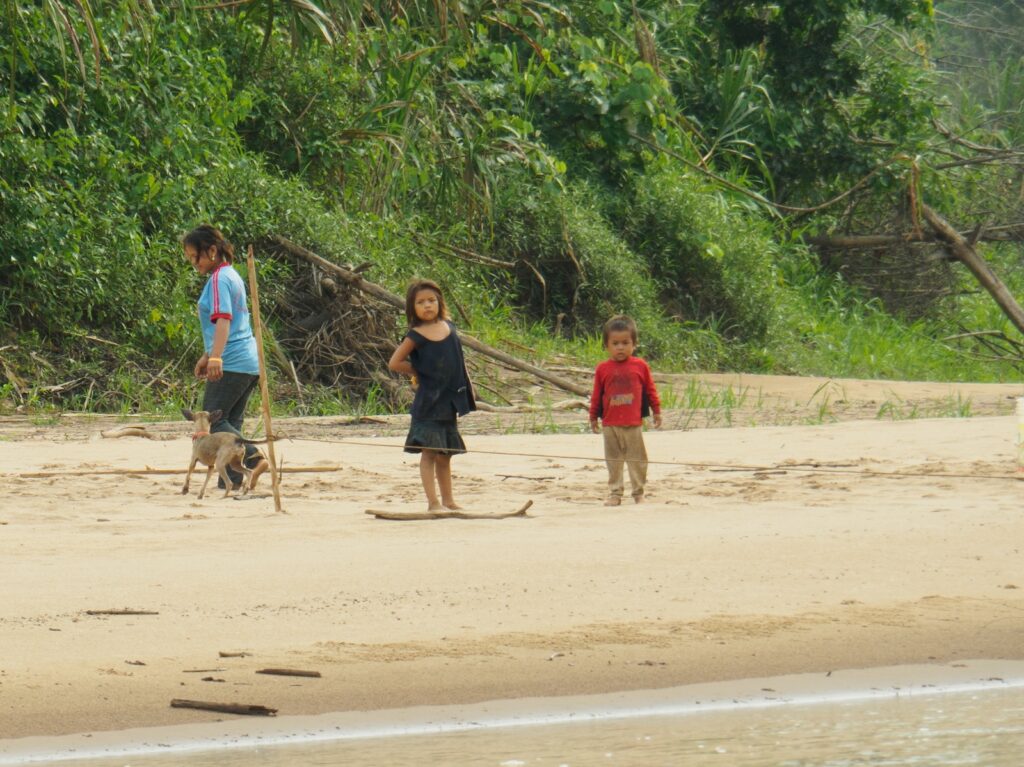
Is it any wonder that conscious consumers have developed a wariness, a queasiness even about purchasing gold? Unfortunately, concerned jewelry makers have not had a satisfactory solution to offer. Gold supply chains have historically been notoriously obscure and untraceable.
Many jewelry makers advertise that they use primarily reclaimed or recycled gold. While this is a good first step, it obviously did not prevent or resolve the Amazon gold mining disaster. It did not save the rainforest.
We share our customers’ concerns; as a jewelry maker, I am unwilling to become an accomplice to labor exploitation and planetary degradation. When a person is ready to purchase a beautiful piece of gold jewelry, whether for themselves or as a meaningful gift for a loved one, I have recommended that they ask questions about the source of the gold and I have developed a set of questions for them to use in discussions with the jewelry seller.
Yet, too often, sellers have no answers. We want better options.

What We Want Is Ethically Sourced and Traceable Gold
They’ve said it couldn’t be done, but what if we could buy gold that was traceable back to a specific mine?
What if that mine were independently certified to meet the best mining practices, and the costs of these improved practices was built in to the gold price through a premium?
What if it were certified that the miners were being paid fairly and working conditions were safeguarding their health?
What if it were certified that the mining practices were aimed at preserving the environment?
And we are not finished.
We Want Our Gold Purchases to Give Back to the Originating Communities
What if the mine certification process required that a portion of gold sales be used to invest in improving the communities around the mine, by funding projects such as re-forestation and health clinics for the 60% of Peruvian citizens now estimated to be affected by mercury poisoning?
What if the certification resulted in a traceable gold supply chain so we could specifically target our metal purchasing to improve the economic, environmental and social stability of communities in our own Western Hemisphere?
What if we who make artisanal jewelry could at last invite our customers to participate in a virtuous cycle with their jewelry purchases, by offering them quality ecological gold that they can be proud of even as they enjoy their treasures?
An impossible dream? Not any longer, thanks to innovative and painstaking organizing work that has been done over the past 20 years by the Alliance for Responsible Mining, an international non-profit organization and its allies.
Here is how the community development work of ARM and its Fairmined certification standard is helping to turn things around in Peru and other countries where it works.
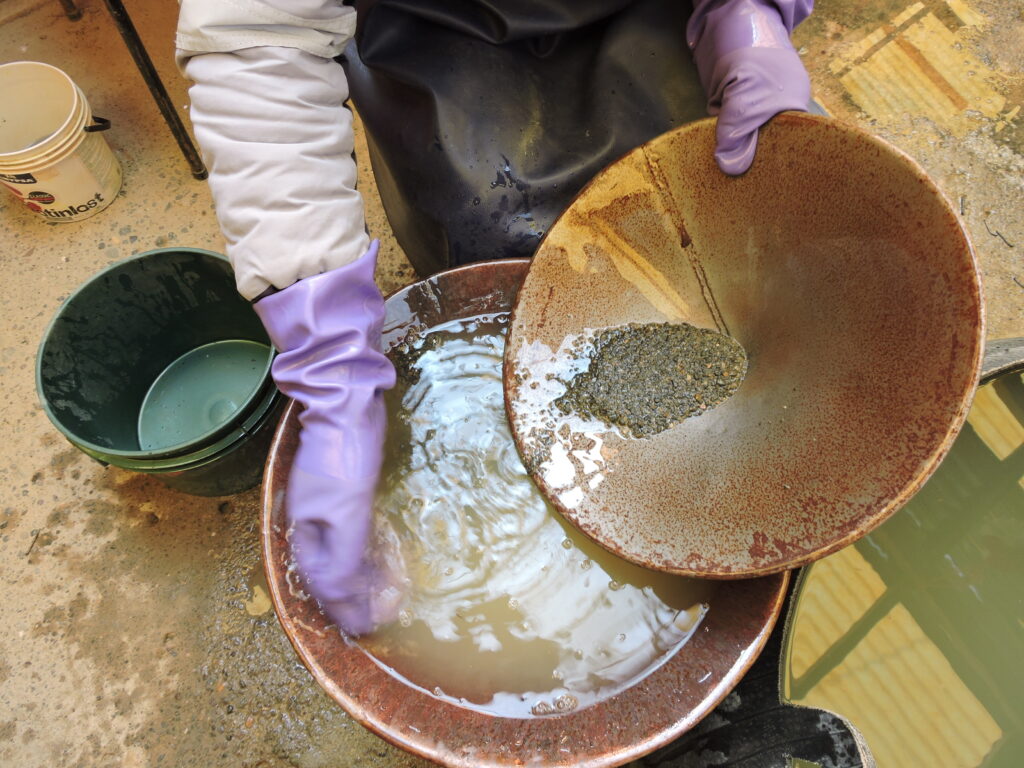
The Stick, The Carrot and the Consumer
The effort to thoughtfully manage resource extraction in any region requires a robust combination of government action, mining sector development and cultivation of an educated consumer base. The progress of the effort in Peru demonstrates that it is possible to move from a vicious cycle of destructive extraction to a virtuous cycle, one that preserves the environment, benefits small scale gold miners and their families as well as delivering gold to eager buyers in North America and elsewhere.
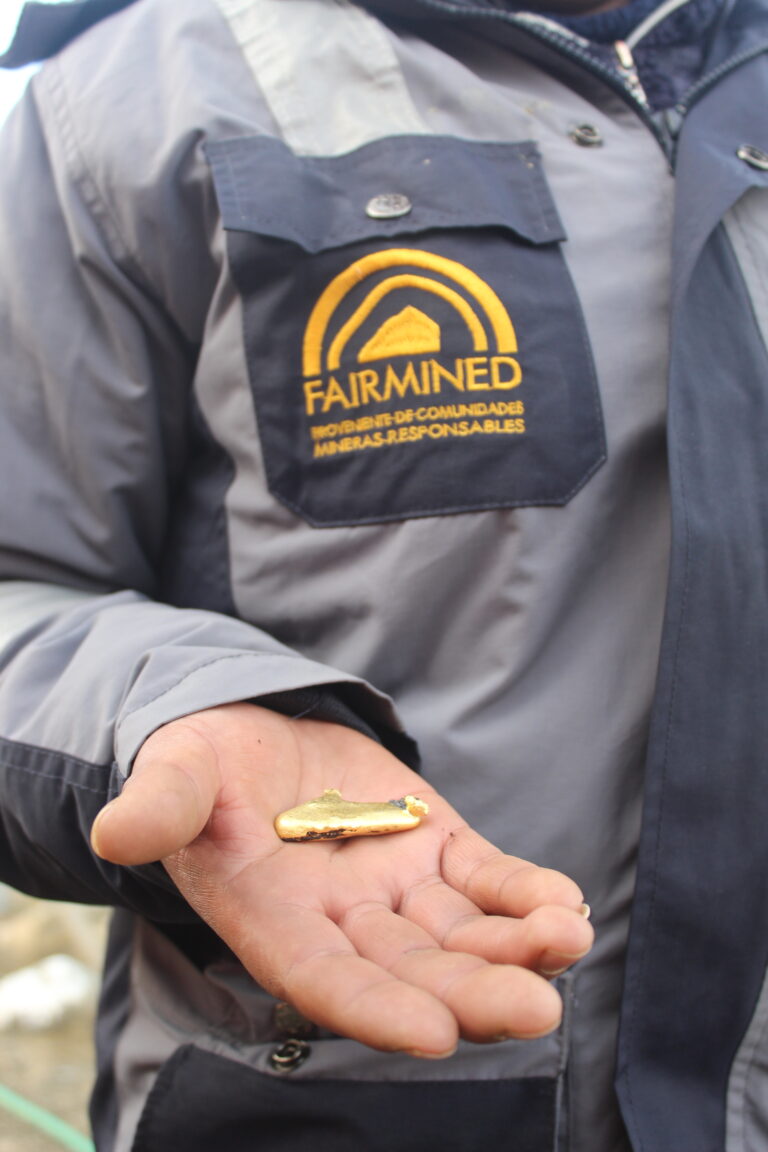
The Stick
In 2019 the Peruvian government launched an effort dubbed “Operation Mercury” to stop illegal mining in the Amazon area. Police and military were deployed to the most active mining areas to halt the rainforest mining and disperse workers. Mining structures were blown up or burned and miners were arrested. For a time, mining sites were emptied although not rehabilitated. Some government regulation efforts were met with civil unrest including deadly clashes with miners. When police were redeployed away from the area to deal with the Covid-19 pandemic in 2020, illegal mining activity resumed.
Clearly the Stick of government enforcement was not by itself sufficient to control the gold rush. The problem is mining is much more lucrative for workers than other employment available to them in their home villages, reports the Smithsonian Magazine in an investigative article. The risks to the miners are much greater though as there are numerous cave-ins and other industrial accidents at the unregulated mining sites, and many deaths occurred.
The Carrot
The NGO Alliance for Responsible Mining (ARM), has been working in the region since 2004 to establish relationships with actors all along the gold supply line. Using a consensus based process, they developed a set of mine standards and practices termed “Fairmined” that aims to transform illegal and destructive mining into an asset for their communities.
The Consumer
The gold consumer is, of course, a vital participant in any gold rush. If no one were buying the illegal gold coming from the Amazon, the motivation for gain that drives the mining would disappear and the rainforest would not be in danger.
But how would the consumer even know this was where their gold was coming from or what the circumstances were there? “Dirty gold” looks and tests the same as clean gold. Gold supply chains have historically been structured in such a way that there is little visibility into the source of the gold or where it was removed from the ground. Gold from all over the world is sold through numerous middlemen to refiners who melt and mix it all together before selling it on to users such as manufacturers and jewelers.
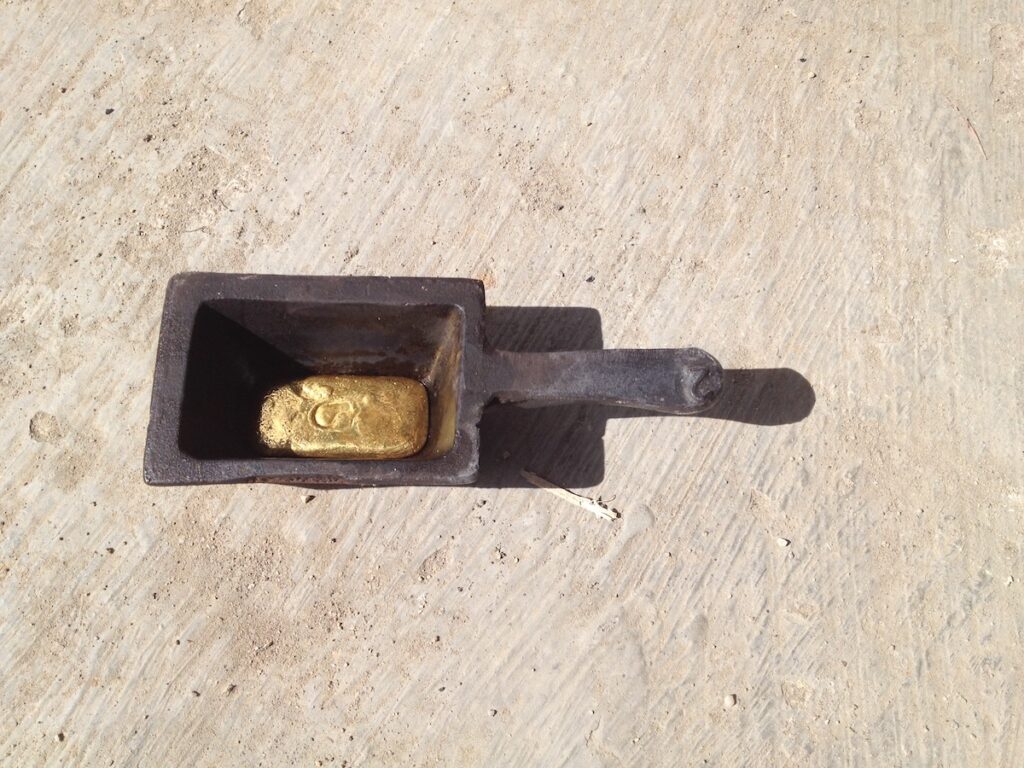
As a result of this “untraceable” supply chain structure, a consumer who hopes to buy a nice gold ring or a gold necklace has no way of knowing where their gold is coming from. It could be coming from a mine using the most advanced practices and paying fair wages to miners. Or it could have originated from a clandestine pit deep in the Amazon where workers, many of them children, are mixing mercury-laced mud with their feet. Dirty gold, indeed.
And so the ARM worked to develop a traceable gold supply chain structure that could allow gold buyers to know with confidence that their gold was coming from a mine certified by Fairmined. This new supply chain created a pathway as well for certified mines. It allowed them to access international gold markets and thus receive higher payment for their goods, rather than selling to local buyers for much less.
Pressure for traceability has also come from the need to comply with sanctions on Russian-produced gold imposed as a result of the Russian war in Ukraine. Traceable gold now has more value than ever before.
Overwhelmed Peruvian officials recognize that they cannot control the destructive gold rush on their own, and buyers must be part of the solution. They plead with North American and other buyers to purchase only certified or “green” gold. Ernesto Montanos, Minister of Energy of the Madre de Dios Region said in an interview with PBS, “All the countries that are consumers of gold, recipients of gold, what they have to demand is to buy green gold, ecologic gold that adheres to all quality standards, to the point where there is no excuse to buy illegal minerals.”
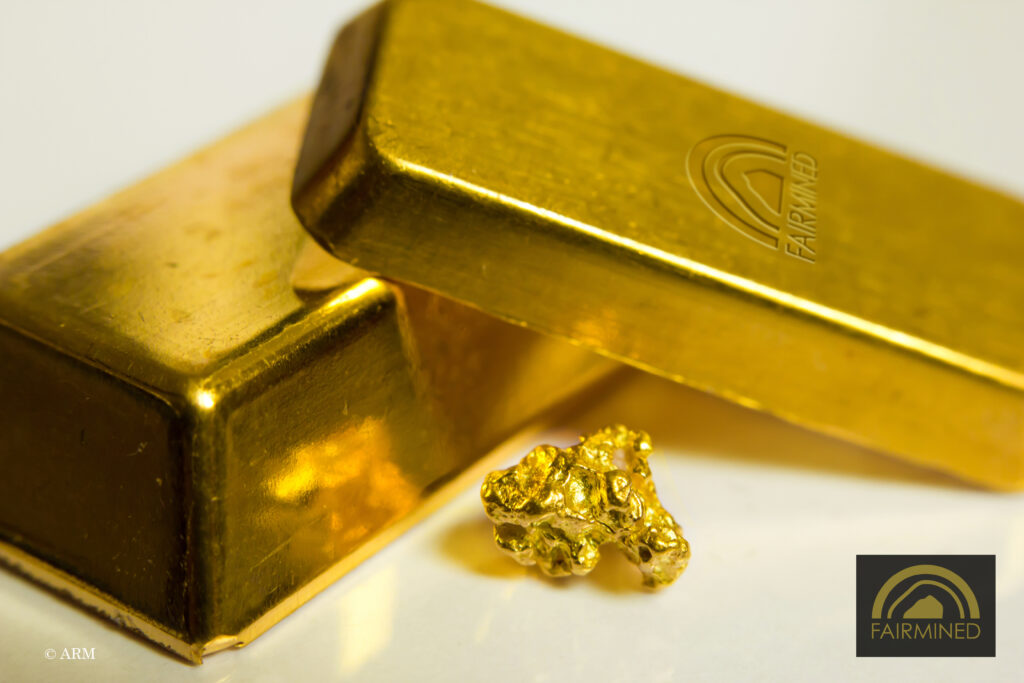
Progress and Recognition
The Fairmined standard has been embraced by prestigious international organizations interested in helping to improve this economic activity.
The Nobel Peace Prize has been fabricated with Fairmined certified gold since 2015. The use of Fairmined gold was introduced by the Mint of Norway, owned by the Samlerhuset Group. Samlerhuset states that with this gesture they hope to open more eyes to the problems faced by gold miners around the world and promote responsible supply chains.
The Palm D’Or of the Cannes Film Festival has been fabricated with Fairmined certified gold since 2014.
As the Nobel Peace Center puts it, “The Fairmined certification assures that responsible working conditions and environmental considerations are adhered to.”
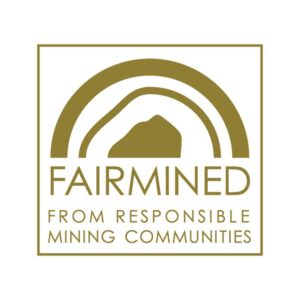
Fairmined Gold Arrives in My Studio
I am thrilled. My studio has now completed the process to become a Fairmined licensed jewelry brand. Now I am able to access and utilize this traceable and ethical gold in my work. I can provide to my customers the guarantee that the gold used in the creation of their jewel is 100% Fairmined gold.
I am so pleased to bring this benefit of peace of mind to my quality conscious friends who appreciate the value of jewelry with an authentic environmental and social pedigree. That is truly gold to be proud of.
My new collection, the Fairmined Americas Collection, featuring Fairmined gold jewelry is coming this holiday season. At last, truly eco-friendly gold earrings and sustainable gold necklaces will be here for holiday treats. So every time you wear them, you become part of that virtuous cycle and you can feel the goodness flowing from the miners and the Amazon to you and back again.


